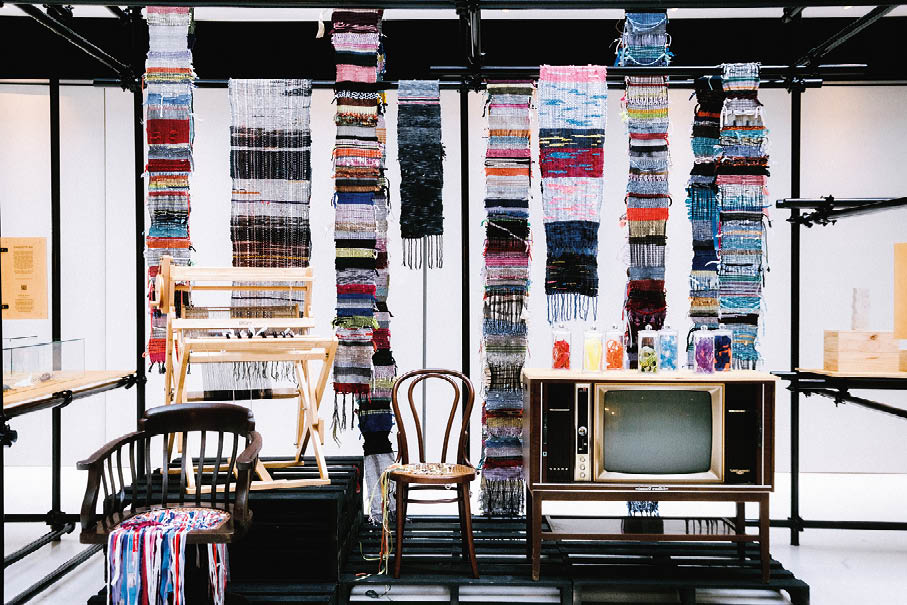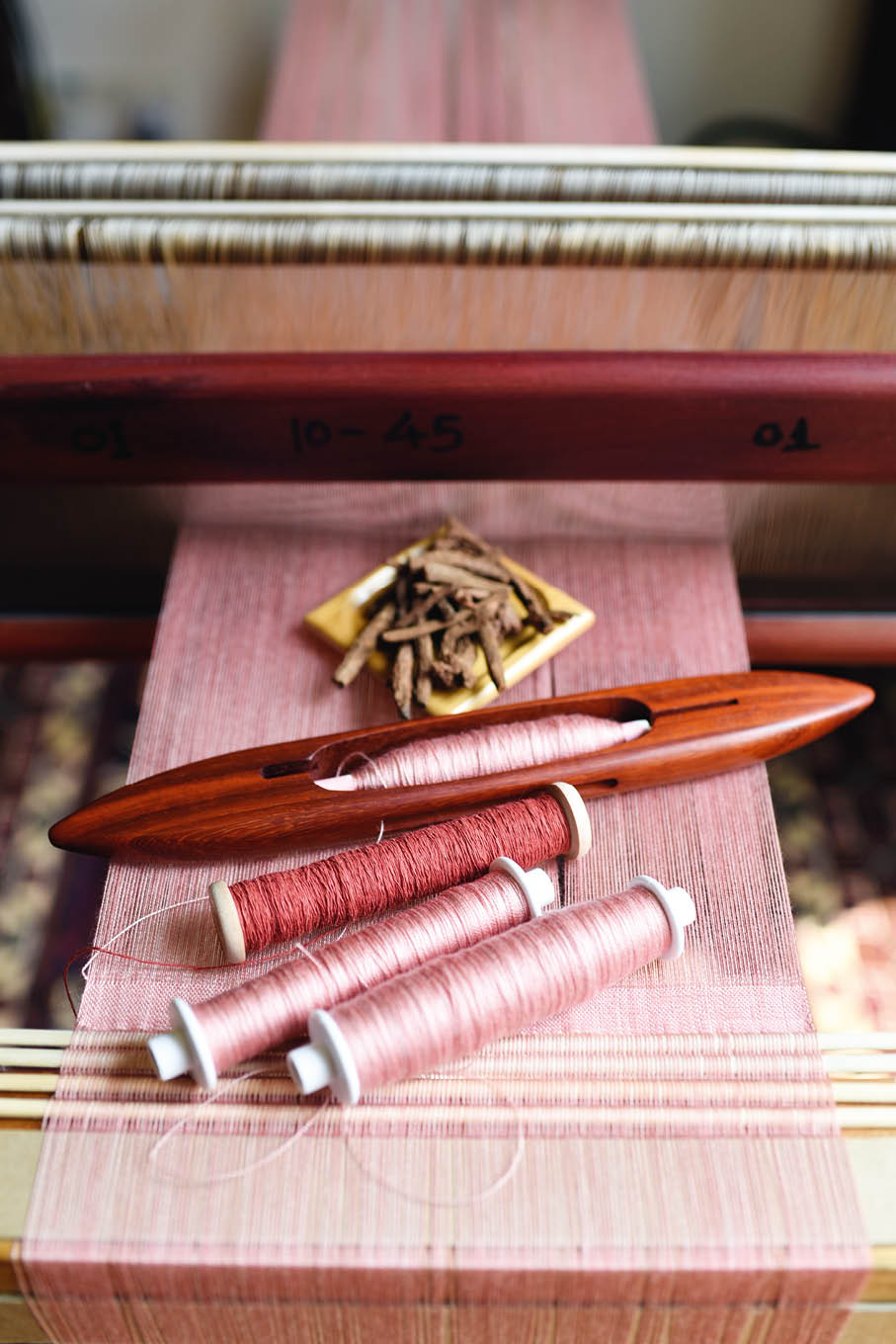A large loom dwells in the corner of Lynelle Barrett’s living room. Of Swedish make, its stirring frame of pine and inscrutable guts of “shaft, heddle and weft,” sit like a pet dragon on the hearth — a reminder that to loom is also a verb. On it, Barrett, 59, has threaded the pattern for some cheery dishrags. She is a weaver, part of the small but distinct community that has sprung up on the island. With yarn, looms and a rare gift for patience, the weavers have devoted themselves to the ancient craft of cloth-making. But their idyllic vocation conceals a secret defiance: they aren’t supposed to be here.
A cursory glance at history unearths the dearth of local weaving traditions. “I think there were rattan weavers once,” says Natalia Tan, weaver and artist, “but they died and faded into obscurity.” She doesn’t mention the indigenous Orang Laut, who wove Bubu traps to catch fish. Of their ilk, only three living practitioners remain. Besides, neither set bothered with textiles. The stark void is rare. Almost every other culture has been weaving for millennia, moved first by necessity and later, art. Singapore, which began as a port city, seemingly resisted both and for the most part has operated on a principle of pristine indifference. As recently as ten years ago, there were no weavers. Now, we have two schools, while our metropolitan cousins, Hong Kong and Kuala Lumpur, still tarry at zero.

At the centre of this unlikely flourishing is a tight-knit guild of women. In 2018, two of them — Koh Chen Chen, 41 and Goh Hui Lian, 46— founded Craft Atelier, the first weaving studio on our shores and the backbone of the local community. The coterie also includes Autumn Brown, 36, who opened the second studio, Barrett and Tan, 32. The latter two conduct guerrilla demonstrations, planting their looms in public spaces for anyone to try. These five women are now surrounded by at least a thousand recorded acolytes, based on registration data from Craft Atelier. Most have passed through the studios; not captured are the roving autodidacts.
“There’s a human impulse to make things, not with our phones but with our hands.”
And their numbers are only poised to rise. “We are seeing a resurgence of craft,” declares Brown. Barrett is more specific. She touts our milieu as the second coming of the Arts and Crafts movement, a “knee-jerk” reaction to the chill of digitisation. Koh corroborates: “At the start, we used to get mostly mothers, now we get children, young women, retirees, even men.”
The pioneers first encountered weaving overseas. Barrett was entranced by a Catu weaver in Laos, whom she begged to teach her that very night. Tan trailed a friend to a Saori workshop in rural Osaka, where she weaved “like a monster” for three days straight. The studio founders got their education in the guilds of North America, legacy of a bucolic past.
Still, that is only half the story. Chantelle Lim, 25, a student-turned-teacher, started weaving at 21, first on her own and later under the tutelage of Tan–without ever leaving the country. “I was just searching for better fabrics,” she says. (Though a transfixing demonstration at the Asian Civilisations Museum had also been influential) And then, with a rueful laugh, “I wanted to be a peasant.” The pastoral instinct underpinning this sentiment is echoed by the other women.“There’s a human impulse to make things,” Barrett observes, “not with our phones, but with our hands.” They gesture at a nostalgia for an imagined past: a time when we made things and used the things we made.

Surprisingly, all gush about the enthralling logic of the loom and its hypnotic mathematics. After all, they rush to tell me, “the Jacquard loom was the world’s first computer.” While weaving, the undulating threads of the loom rise and fall in a binary sequence, mechanics that inspired the binary codes of computing. It captivates Koh, who, before her induction, never guessed that something “so structured could be so artistic.”
But most of all, they relish the labour. For Lim, the complex operation of planning, stringing, then executing the pattern is a sweet escape. “You’re using your hands, feet and brain. There’s no time to think about anything else,” she says. Then laughing, adds, “the first time I weaved at Natalia’s I didn’t drink water for four hours. It was mad.” Barrett concurs. Her dishrags would come along a lot faster with a flying shuttle, she informs me, but the work is rewarding.

It’s a sensibility that has fallen out of fashion, victim of the grey assembly line. The weavers seem determined to resurrect it, lingering on the charisma of the handmade object. “It has more life,” says Barrett, “more thought,” says Koh, “more me,” says Lim. The desire for the distinctive and individual can extend to every part of production — Lim confesses she once grew her own cotton. She shows me a pair of baby shorts, woven from scratch. It is surprising to touch, soft in places and bumpy in others where the fabric has bunched or a seed has caught. They are the most poignant shorts I have ever seen and the hems skew slightly uneven. The loveliness of its flaws recalls the words of John Ruskin, whose blistering invectives against 19th century industrialisation double as accidental odes to craft: “it is not coarse cutting, not blunt cutting, that is necessarily bad, but it is cold cutting – the look of equal trouble everywhere – the smooth, diffused tranquillity of heartless pains.”
“I call myself a textile artist because you’ve got to differentiate yourself from craft.”
Imperfection, it surfaces, is a bone of contention among them; some exalt it, others scorn it. Barrett’s wyvern loom bears a dark-wood shaft inscribed with an unfurling fern, much like the flawless curlicues of her weave. It is the charm for perfection. Tan has a competing philosophy. A Saori disciple, she weaves by intuition alone. A tearaway school, the first tenet of Saori is an order: consider the difference between man and a machine. Tan’s oeuvre is a riotous landscape of cavorting colours, textures and emotions. Fuchsia jostles with straw; knots, snaggles and bulbs bloom; there are no mistakes. Both schools possess a keen humanity and the tension between them feels familiar, a consequence of warring desires.

Some differences run deeper still, like a rift between east and west. Asian techniques, Lim says, are more “spiritual, even animist,” whereas European techniques are strictly ornamental. Barrett, an American, has spent almost a decade studying Southeast Asian traditions for the same reason, often chasing them right to the source-the villages that make up their birthplaces. (On one such expedition, she befriended the Queen of Malaysia.) She has steeped herself in Iban culture, making such frequent pilgrimages to Borneo that a local ikat weaving collective has taken her in. Known as the dream weavers — for their patterns come to them in dreams — weavers and warriors are of equal status in their society. Their abstract motifs are imbued with cosmic power and Barrett must take care not to attempt certain patterns or risk grave personal injury. In the North American canon, the stakes tend to be more aesthetic.
Nearing the end of my visit to Barrett’s atmospheric apartment, she interrupts our patter about the woes of brocade with a sudden aside: “I call myself a textile artist because you’ve got to differentiate yourself from craft.” It is a matter of prestige. “Not because I see it differently,” she hastens to add, “but because the world does.” The hierarchy, or the world, upsets me, so I bring it up with Lim, who has spent most of our interview supine on her bed. “Yeah,” she mumbles, “crafting can sound primitive. It implies you lack vision.” “Then would you like to be called an artist?” I ask. “No,” she shrugs, with the blithe insouciance of youth, “I don’t care.”
Order your copy of the May/June ‘Guardian’ issue of Vogue Singapore online or pick it up on newsstands now.





